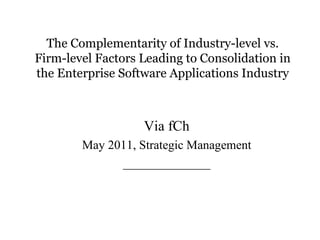
Strategic Future Orcl Vs Sap
- 1. The Complementarity of Industry-level vs. Firm-level Factors Leading to Consolidation in the Enterprise Software Applications Industry Via fCh May 2011, Strategic Management ______________
- 2. The What & Why • Theoretical model as premise for testing industry consolidation • Exploring/exposing theoretical and methodological linkages between industry and firm level factors leading up to consolidation • Mix of qualitative and quantitative methods • Research opportunity associated with a natural experiment
- 3. Theoretical angles • Environmental munificence (Dess et al. 1984; Castrogiovanni 1991) • Industry shakeout (Agarwal 1998; Klepper & Simons 2005) • Dominant design – Complementary assets (Tushman & Anderson 1986; Rothaermel & Hill 2005); – Platform economies (Evans, Hagiu & Schmalensee 2006)
- 4. Industry facts • 300 publicly traded enterprise software firms in 1997, 111 in 2006 (Cusumano 2008) • Growing revenues ($253.7Bn in 2011), increasing concentration (3 The evolution of the number of publicly traded firms control 43% of the enterprise software applications firms listed on the US capital markets market)
- 5. Hypothesized factors leading to industry consolidation • Y2K (Jacobs & Weston 2007; Cusumano 2008) • “.com” Crash, March 11, 2000 ((Jacobs & Weston 2007; Cusumano 2008) • The diffusion of free and open source software (Cusumano 2008) • The increase contribution of services to firms’ revenue (Cusumano 2008)
- 6. More industry facts • ERP has a modular architecture – Its benefits are realized when the modules are integrated (Markus et al. 2000) – The more modules the more risk of implementation failure (Davenport 1998) “At the heart of an enterprise system is a central database that draws data from and feeds data into a – Failure rate in ERP series of applications supporting diverse company functions. Using a single database dramatically implementation 40-60% streamlines the flow of information throughout a business” (Davenport 1998).
- 7. Theory Supported Hypotheses • H1: Sudden decrease in environment munificence leads to industry shakeout (Utterback & Suarez 1993; Klepper & Simons 2005) • H2: The dominant design emerges as result of platform economies—scale, scope, and skill (Teece 1986; Rothaermel & Hill 2005; Evans et al. 2007)
- 8. Illustration of the dominant design As of 2005, Oracle has spent more than $50Bn on acquiring more than 50 companies •Platform economies •Absorptive capacity •Signaling •Lock-in effects / Barriers of entry
- 9. Analytical hypothesis H3: The market tends to settle towards the Bertrand equilibrium (marginal cost of the most efficient player’s marginal cost, provided that there is no collusion) Market equilibrium under imperfect competition can occur at many points on the demand curve. In this figure, which assumes that marginal costs are constant over all output ranges, the equilibrium of the Bertrand game occurs at point C, also corresponding to the perfectly competitive outcome. The perfect-cartel outcome occurs at point M, also corresponding to the monopoly outcome. Many solutions may occur between points M and C, depending on the specific assumptions made about how firms compete. For example, the equilibrium of the Cournot game might occur at a point such as A. The deadweight loss given by the shaded triangle is increasing as one moves from point C to M.
- 10. Q&A Thank You!
